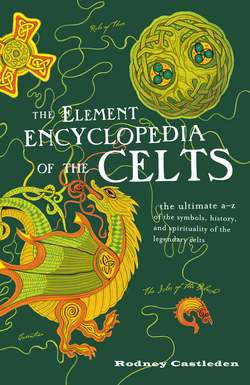Читать книгу The Element Encyclopedia of the Celts - Rodney Castleden - Страница 175
LANGUAGE
ОглавлениеThe old languages still spoken in the Atlantic Celtic lands are related to one another, though they are not all as closely related as once believed. The current view among linguists is that historically there are two families of Celtic languages. The Q-Celtic family, known as Goidelic, has a western Gaelic branch from which Irish is descended and an eastern Gaelic branch from which Scottish Gaelic and Manx Gaelic are descended. Then there is a P-Celtic family, known as Brittonic, with a northern Brittonic branch from which Welsh developed and a southern Brittonic branch from which Cornish and Breton are descended. This division may help to explain why Welsh-speakers cannot understand Gaelic-speakers.
The “Q” and “P” families were first identified in the early eighteenth century by Edward Lhuyd. Q-Celtic is recognized from the presence of the “Q” sound in the word Mac, “son of.” P-Celtic has the “P” sound in the corresponding position: Map. This “P/Q” exchange is found in other words as well.
The relationship between the Cornish and Breton languages is the closest. This is explained by the exodus of Britons, via Cornwall, in the Dark Ages, as they were driven out by the advancing Anglo-Saxons. These British refugees fled westward through southern Britain to Cornwall, then crossed to Brittany in considerable numbers, and they took their language with them.
In the Middle Ages, Scotland was divided culturally between Highlands and Lowlands. The Highlanders spoke Gaelic (Irish “Celtic” or Erse), while the Lowlanders spoke Scots, which was a Germanic language close to English. This difference was perhaps a legacy of the Anglo-Saxon colonization of the Scottish Lowlands in the Dark Ages.
In the late 1980s Professor Colin Renfrew put forward the view that Celtic speech evolved from its Indo-European ancestor in the British Isles and the adjacent continent at some time after 4000 BC. Professor Renfrew believes that the Celtic language was not taken to Britain at all, but developed in situ. This is very much in line with the general view emerging of Celtic culture as a whole.
Much of what was passed on to others was learned by listening. Little was written down (See Writing). There were nevertheless the means to write. The Ogham alphabet was made of combinations of short and long marks, often chipped along the edges of stones. It was an ideal method for recording someone’s name on a gravestone. Ogham was widely used in southern Ireland, and more than 900 examples have been found in Britain and Ireland as a whole.
It is widely believed that the Celtic language was completely wiped out in England, but there are many surviving Celtic place-names. For a long time after the Anglo-Saxon colonization period (about AD 400–700), Celtic and Anglo-Saxon names existed side by side. Sometimes it is the Celtic name rather than the English name that we know today. The Cotswold Windrush River had an English name, Dikler, which died out as late as the sixteenth century; we now call the river by its older Celtic name, even though it has (or had) an Anglo-Saxon name. The Cotswold Hills take their name from a Celtic word and an Anglo-Saxon word. Cuda was a goddess of the Dobunni tribe; wold was the Anglo-Saxon word for a wooded upland.
In the Roman occupation and the post-Roman period, Celtic kings and princes thought it smart to use Latin. Grave markers from the fifth and sixth centuries are often inscribed in Latin. A gravestone at Penmacho in North Wales reads CARAVSIVS HIC IACIT IN HOC CONGERIES LAPIDVM, “Here lies Carausius in this heap of stones.”
